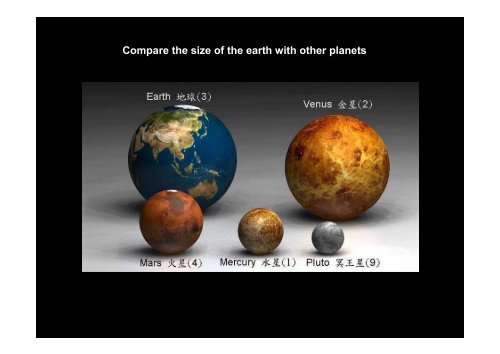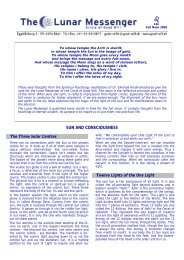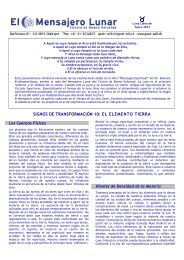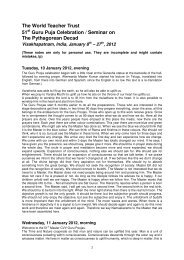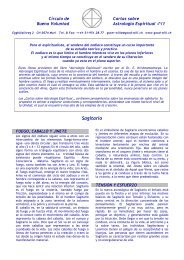Compare the size of the earth with other planets
Compare the size of the earth with other planets
Compare the size of the earth with other planets
Create successful ePaper yourself
Turn your PDF publications into a flip-book with our unique Google optimized e-Paper software.
<strong>Compare</strong> <strong>the</strong> <strong>size</strong> <strong>of</strong> <strong>the</strong> <strong>earth</strong> <strong>with</strong> o<strong>the</strong>r <strong>planets</strong>
This is<br />
<strong>the</strong> Earth<br />
Now compare it <strong>with</strong> Uranus & Neptune
Now Earth against Sun<br />
Against Sun, Earth is like a dot<br />
Think !! Where do you find yourself now<br />
This is<br />
<strong>the</strong> Earth
Suppose if we assume<br />
Sun as a 100 inch - for<br />
Demo<br />
Actual<br />
Scale<br />
Scale<br />
Diameter<br />
Diameter<br />
Diameter<br />
Body<br />
kilometers<br />
inches<br />
mm<br />
Sun<br />
1391900<br />
100<br />
Mercury<br />
4866<br />
8.88<br />
Venus<br />
12106<br />
22.092<br />
Earth<br />
12742<br />
23.252<br />
Mars<br />
6760<br />
12.336<br />
Jupiter<br />
139516<br />
254.595<br />
Saturn<br />
116438<br />
212.481<br />
Uranus<br />
46940<br />
85.658<br />
Neptune<br />
45432<br />
82.906<br />
Pluto<br />
3400<br />
6.204<br />
The Earth would<br />
be 23.253 mm
As we have compared <strong>the</strong><br />
Earth <strong>with</strong> Sun<br />
Now !!<br />
Start comparing <strong>the</strong> Sun <strong>with</strong><br />
<strong>the</strong> Universe
The closest star to <strong>the</strong> Sun is only 7000 times fur<strong>the</strong>r than <strong>the</strong> edge <strong>of</strong> our solar system.<br />
This map shows all <strong>of</strong> <strong>the</strong> stellar systems that lie <strong>with</strong>in 12.5 light years from us.
This map is a plot <strong>of</strong> <strong>the</strong> 1500 most luminous stars <strong>with</strong>in 250 light years.<br />
All <strong>of</strong> <strong>the</strong>se stars are much more luminous than <strong>the</strong> Sun and most <strong>of</strong> <strong>the</strong>m<br />
can be seen <strong>with</strong> <strong>the</strong> naked eye. About one third <strong>of</strong> <strong>the</strong> stars visible <strong>with</strong> <strong>the</strong><br />
naked eye lie <strong>with</strong>in 250 light years, even though this is only a tiny part <strong>of</strong> our galaxy.
The Sun is<br />
located in <strong>the</strong><br />
Orion Arm - a<br />
fairly minor arm<br />
compared <strong>with</strong><br />
<strong>the</strong> Sagittarius<br />
Arm,<br />
which is<br />
located closer<br />
to <strong>the</strong> galactic<br />
centre.<br />
The map shows several stars visible <strong>with</strong> <strong>the</strong> naked eye which are located deep <strong>with</strong>in <strong>the</strong><br />
Orion arm. The most notable group <strong>of</strong> stars here are main stars in <strong>the</strong> constellation <strong>of</strong> Orion<br />
-from which <strong>the</strong> spiral arm gets its name. All <strong>of</strong> <strong>the</strong>se stars are bright giant and supergiant<br />
-stars, thousands <strong>of</strong> times more luminous than <strong>the</strong> Sun. The most luminous star on <strong>the</strong> map<br />
-is Rho Cassiopeia - to us 4000 light years away, it is a dim naked eye star, but in reality<br />
-it is a huge supergiant star 100 000 times more luminous than our Sun.
A spiral galaxy <strong>of</strong> at least two hundred billion stars. Our Sun is buried deep <strong>with</strong>in <strong>the</strong><br />
Orion Arm about 26 000 light years from <strong>the</strong> centre. Towards <strong>the</strong> centre <strong>of</strong> <strong>the</strong> Galaxy<br />
<strong>the</strong> stars are packed toge<strong>the</strong>r much closer than <strong>the</strong>y are where we live. Notice also <strong>the</strong><br />
presence <strong>of</strong> small globular clusters <strong>of</strong> stars which lie well outside <strong>the</strong> plane <strong>of</strong> <strong>the</strong> Galaxy,<br />
and notice too <strong>the</strong> presence <strong>of</strong> a nearby dwarf galaxy - <strong>the</strong> Sagittarius dwarf <br />
which is slowly being swallowed up by our own galaxy.
Although <strong>the</strong> Milky Way is but one <strong>of</strong> billions <strong>of</strong> galaxies in <strong>the</strong> universe,<br />
<strong>the</strong> Galaxy has special significance to humanity as<br />
it is <strong>the</strong> home <strong>of</strong> <strong>the</strong> solar system.<br />
As a guide to <strong>the</strong> relative physical scale <strong>of</strong> <strong>the</strong> Milky Way,<br />
if <strong>the</strong> galaxy were reduced to 130 km (80 mi) in diameter,<br />
<strong>the</strong> solar system would be a mere 2 mm (0.08 in) in width.
Number <strong>of</strong> large galaxies <strong>with</strong>in 500 000 light years = 1<br />
Number <strong>of</strong> dwarf galaxies <strong>with</strong>in 500 000 light years = 9<br />
Number <strong>of</strong> stars <strong>with</strong>in 500 000 light years = 225 billion .<br />
The Milky Way is surrounded by several dwarf galaxies, ypically containing a<br />
few tens <strong>of</strong> millions <strong>of</strong> stars, which is insignificant compared <strong>with</strong> <strong>the</strong> number <strong>of</strong><br />
stars in <strong>the</strong> Milky Way itself. This map shows <strong>the</strong> closest dwarf galaxies,<br />
<strong>the</strong>y are all gravitationally bound to <strong>the</strong> Milky Way requiring billions <strong>of</strong> years to orbit it.
Can you find <strong>the</strong><br />
Milky Way in this<br />
Our Milky Way galaxy<br />
is part <strong>of</strong> Local Group<br />
& it is in centre<br />
Number <strong>of</strong> galaxy groups <strong>with</strong>in 100 million light years = 200<br />
Number <strong>of</strong> large galaxies <strong>with</strong>in 100 million light years = 2500<br />
Number <strong>of</strong> dwarf galaxies <strong>with</strong>in 100 million light years = 25 000<br />
Our galaxy is just one <strong>of</strong> thousands that lie <strong>with</strong>in 100 million light years. The above map<br />
shows how galaxies tend to cluster into groups, <strong>the</strong> largest nearby cluster is <strong>the</strong> Virgo<br />
cluster a concentration <strong>of</strong> several hundred galaxies which dominates <strong>the</strong> galaxy groups<br />
around it. Collectively, all <strong>of</strong> <strong>the</strong>se groups <strong>of</strong> galaxies are known as <strong>the</strong> Virgo Supercluster<br />
The second richest cluster in this volume <strong>of</strong> space is <strong>the</strong> Fornax Cluster, but it is not<br />
nearly as rich as <strong>the</strong> Virgo cluster. Only bright galaxies are depicted on <strong>the</strong> map, our<br />
galaxy is <strong>the</strong> dot in <strong>the</strong> very centre.
Galaxies and clusters <strong>of</strong><br />
galaxies are not uniformly<br />
distributed in <strong>the</strong> Universe,<br />
instead <strong>the</strong>y<br />
collect into vast clusters<br />
and sheets and walls <strong>of</strong><br />
galaxies interspersed <strong>with</strong><br />
large voids in<br />
which very few galaxies<br />
seem to exist. The map<br />
above shows many <strong>of</strong><br />
<strong>the</strong>se superclusters<br />
including <strong>the</strong> Virgo<br />
supercluster - <strong>the</strong> minor<br />
supercluster <strong>of</strong> which our<br />
galaxy is just a minor<br />
member. The entire map<br />
is approximately 7 percent<br />
<strong>of</strong> <strong>the</strong> diameter <strong>of</strong> <strong>the</strong><br />
entire visible Universe.
This map attempts to show<br />
<strong>the</strong> entire visible Universe.<br />
The galaxies in <strong>the</strong> universe<br />
tend to collect into vast<br />
sheets and superclusters <strong>of</strong><br />
galaxies surrounding large<br />
voids giving <strong>the</strong> universe a<br />
cellular appearance.<br />
Because light in <strong>the</strong><br />
universe only<br />
travels at a fixed speed, we<br />
see objects at <strong>the</strong> edge <strong>of</strong><br />
<strong>the</strong> universe when it was<br />
very young up to 14 billion<br />
years ago.
Now Stop Comparing<br />
& start thinking about <strong>the</strong><br />
Knowledge & Power<br />
<strong>of</strong> <strong>the</strong> Creator by seeing this Creation<br />
Dont you ever ponder over <strong>the</strong> signs <strong>of</strong> <strong>the</strong> Creator <br />
All Praise is to <strong>the</strong> Lord <strong>of</strong> <strong>the</strong> Universe<br />
The Almighty, The all-Knowing, The Omnipotent<br />
Can you imagine <strong>the</strong> Knowledge & Power<br />
Of <strong>the</strong> creator <strong>of</strong> this universe


